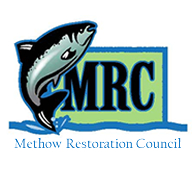

|
Living With the Methow River Monthly Activities and Learning Opportunities October 2017 Riparian Surveys When you think of fish habitat restoration projects, you may think mostly of work done in the water. Woody debris is added to give fish a place to rest and feed, side channels are reconnected to open up off-channel habitat, and culverts are oversized to turn drainpipes into creeks. All of these things are important, but there's another component of habitat restoration you may not be thinking about: the plants on the riverbank. The grasses, bushes, and trees on the riverbank (known as riparian vegetation) provide habitat, shade, and food for a wide variety of animal species. This important habitat is often damaged by fire, flood, and human activity. Plants will always grow around water, of course, but often less-useful invasive species like reed canarygrass take over before native plants can re-establish themselves. Habitat projects in the Methow often include restoration of the riparian zone by re-planting disturbed areas with locally-collected seeds of native species to ensure that the new plantings are well-suited to local conditions. Work in the riparian zone is not over when a project is completed. Once a year, biologists conduct riparian surveys, examining the survival, growth, and shade provided by the restored riparian vegetation. They also note the plants' vigor, measured by seed production and basal sprouting (shoots from the base of a tree or shrub). This data is compared to prior data from the same site and from other sites throughout the Methow. Thanks to planting and site maintenance techniques refined through years of post-project monitoring, survival rates for new plantings are usually quite high, often exceeding 85%. After a few years of growth, planting sites often have many more stems present than were initially planted--showing that the plants are thriving and reproducing. Though much of our work takes place in-channel, out-of-channel work on riparian vegetation also plays a crucial part in the restoration of habitat for endangered salmon and steelhead. Riparian surveys are an important tool to see what we're working with, what we've done, and how our work holds up years down the line.
(Looking for last month? Click here.)
This year’s MRC calendar connects to ADVENTURES, ACTIVITIES AND INFORMATION tailored to each month. If you haven't gotten your calendar yet, you can download an electronic version here. Come back each month and find interactive activities, print outs, and suggested learning opportunities in our community.
|

